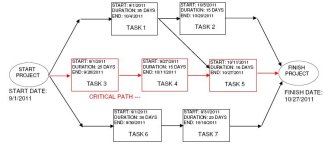Steve Etter
Lifetime Supporting Member + Moderator
We have a machine that is currently down and being completely rebuilt. As part of that rebuild I have a sub-project to replace virtually all the controls, wiring, and conduit on the machine. It was known up-front that replacing my controls would be the critical path and that is no problem, however, the facility is in dire need of the machine and the folks upstairs are pushing for every possible expedite. Once again, no problem, I have pretty good plans, designs, conduit runs, wire-pull lists, etc. and I can get all the man-power I need to work 24/7 to get the job done. The problem I do have is my ability to estimate timing.
I am using Microsoft Project to work up my time-line and I have a very detailed list of most all the tasks that need to be accomplished. While I feel fairly confident that I have captured all the majority of items, I am not confident that I can adequately allocate, but not be too generous with the time required for each task. My worst areas are conduit runs and wire pulls/terminations.
The folks upstairs want me to forward them a copy of my time-line. Obviously, once I do that they will try to take out anything they think is fluff and ask boat-loads of what-if and how-come questions. These are no problem, but the one thing we all know they won’t do is accept the finish date slipping simply because the time was estimated poorly.
So my question is this; how do you all determine how long any given conduit run or wire pull/termination will take? Does anyone have a spreadsheet or chart they use? Please remember this is an aggressive installation so I am looking for more realistic the data you might otherwise use for quoting purposes.
Thanks
Steve
I am using Microsoft Project to work up my time-line and I have a very detailed list of most all the tasks that need to be accomplished. While I feel fairly confident that I have captured all the majority of items, I am not confident that I can adequately allocate, but not be too generous with the time required for each task. My worst areas are conduit runs and wire pulls/terminations.
The folks upstairs want me to forward them a copy of my time-line. Obviously, once I do that they will try to take out anything they think is fluff and ask boat-loads of what-if and how-come questions. These are no problem, but the one thing we all know they won’t do is accept the finish date slipping simply because the time was estimated poorly.
So my question is this; how do you all determine how long any given conduit run or wire pull/termination will take? Does anyone have a spreadsheet or chart they use? Please remember this is an aggressive installation so I am looking for more realistic the data you might otherwise use for quoting purposes.
Thanks
Steve




